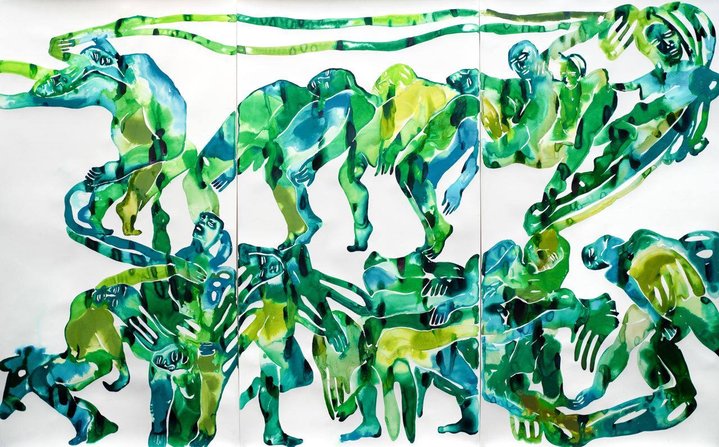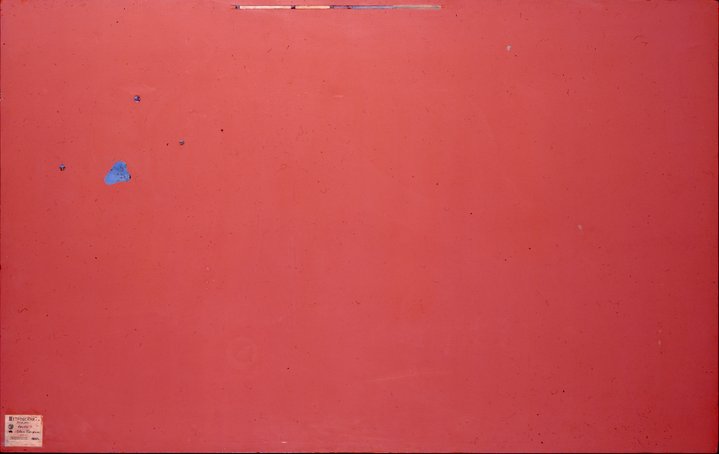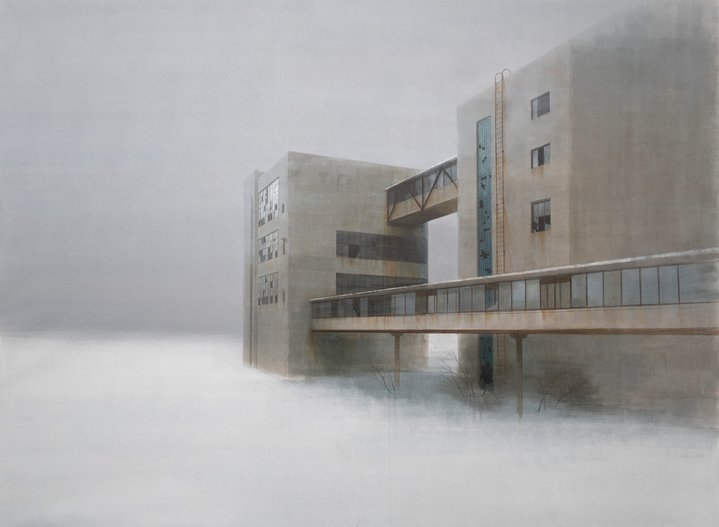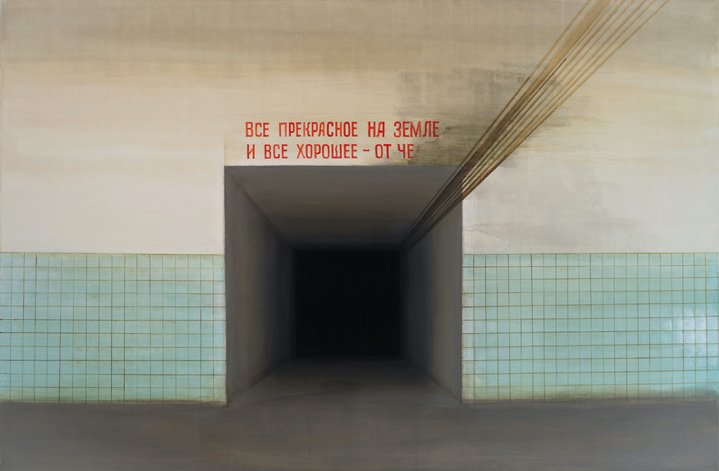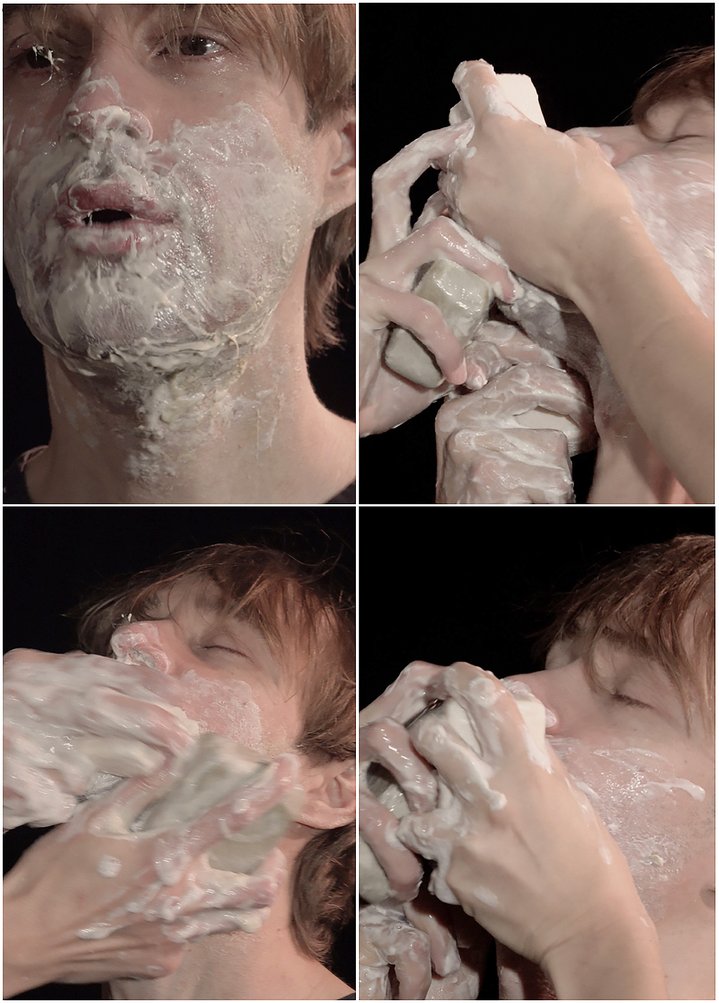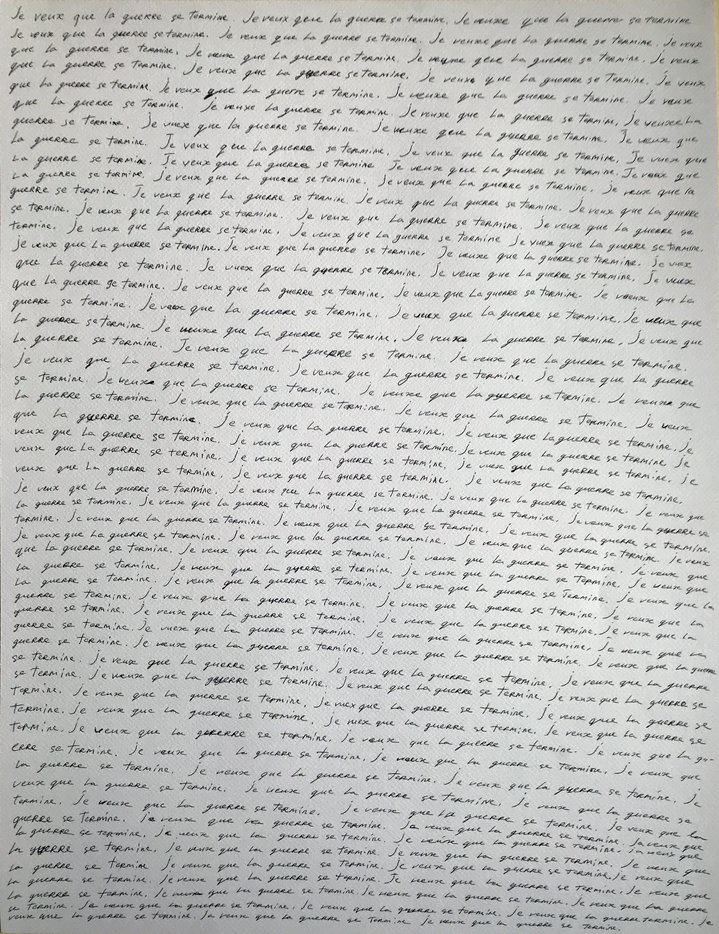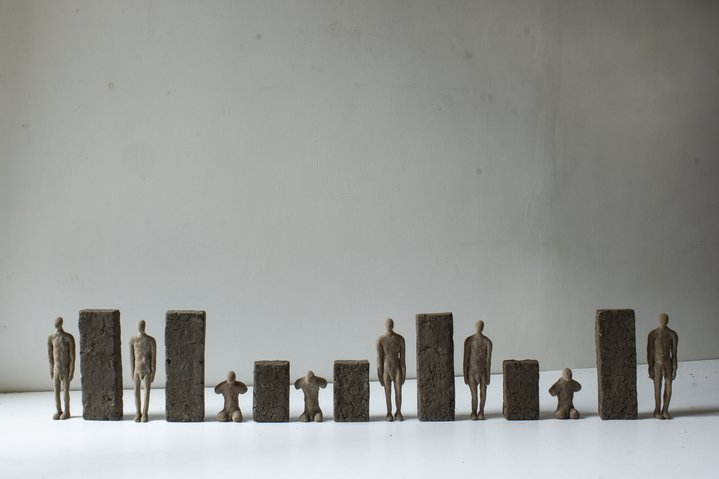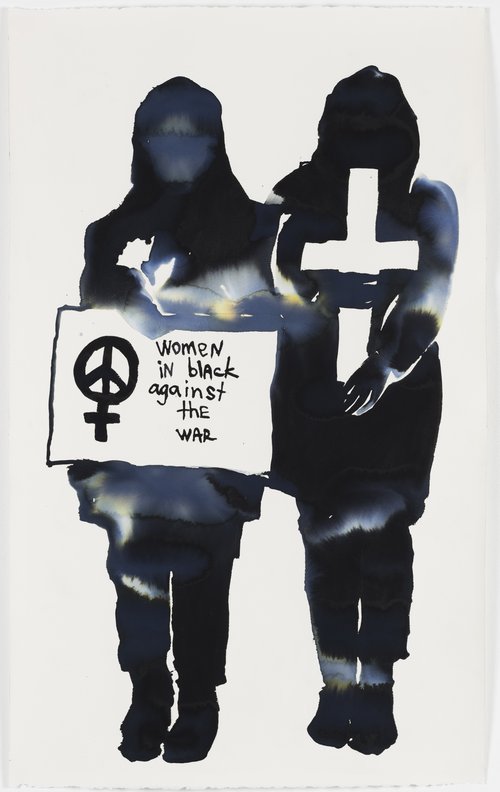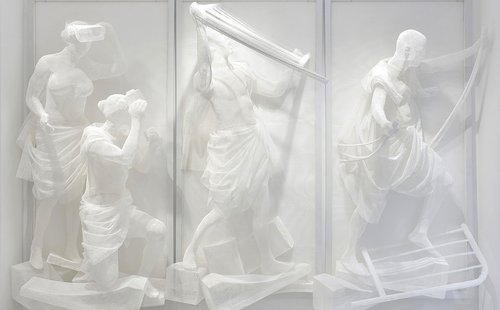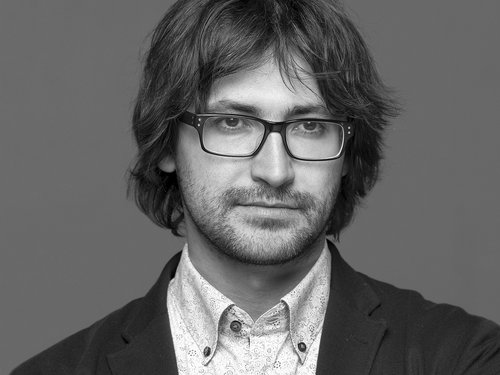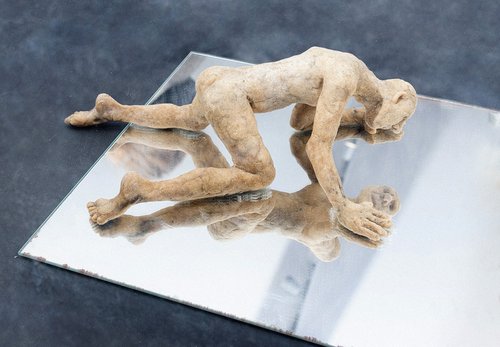Russian Artists Exiled in a Loop

Erik Bulatov. Self portrait, 1968. Courtesy of Dina Vierny Gallery
73-23 is a two-part exhibition in Paris which pays homage to a celebrated exhibition of Soviet non-conformists staged by gallerist Dina Vierny in 1973, and now, half a century later it also gives a voice to four exceptional Russian artists who left their homeland since the invasion of Ukraine to re-invent their artistic practices abroad.
A brief ten-minute stroll separates fifty years of Russian art in exile at ´73-23´ currently on show in Paris at twinned venues, Galerie Dina Vierny and the PAL project. Over at the Rue Jacob there are the leading non-conformist artists, the giants of their generation, Ilya Kabakov (1933–2023), Erik Bulatov (b. 1933), Vladimir Yankilevsky (1938–2018), Oscar Rabin (1928–2018), as well as a little-known contemporary Maxim Arkhangelsky (1926–2007). All chose to emigrate from Soviet Russia with the exception of the latter. Fast forward to the present, emerging art gallery PAL project on Rue de Grenelle is showing four artists, all of them under fifty who have made a name for themselves in Russia: Evgeny Granilshchikov (b.1985) who is currently living in Clermont-Ferrand, France; Andrei Kuzkin (b. 1979) who has a studio practice in Paris; Katya Muromsteva (b. 1990) based now in New York; and Pavel Otdelnov (b. 1979) who moved to London a few years ago. None of them intends to return to Russia any time soon, due to their outspoken opposition to war.
Back in 1973, the Parisian public was introduced to the works of Soviet artists at Galerie Dina Vierny, and incredibly after half a century, these same artworks are currently on display again at 73–23 in what can be seen as a reinterpretation of what was an iconic exhibition Avant-Garde Russe Moscou 73. Vierny is perhaps best known among art circles as the muse of Aristide Maillol (1919-1944), also a talented art dealer and collector. The exhibition was a huge success in its day, extended for several months due to the level of interest but today in what might be a hard act to follow, curator Dmitri Ozerkov invites us to see it with a fresh perspective. Ozerkov, a former Hermitage Museum curator who left Russia because of his anti-war position and now lives in Italy, explains: “My aim became to engage in a dialogue with Dina Vierny´s show in the present in order to gain insight into what is happening now.” Initially, he did not want to draw parallels between the Soviet and post-Soviet generations of artists who experienced emigration and exile. He had wanted to involve the younger artists to bring some fresh perspectives to the ´73´ show, but the parallels emerged in the new historical context of the war in Ukraine. So, ´73–23´ looks at the figure of the artist in a time of turbulent politics with life changing decisions. It addresses the dilemma experienced by these artists of whether to stay or leave home. Granilshchikov, Kuzkin, Muromsteva, and Otdelnov chose a new beginning, and made choices aligned with personal authenticity, declaring a distinctive voice, an anti-war position and statement.
The exhibition space at Galerie Dina Vierny consists of two low ceilinged rooms on the upper floor where there are golden-coloured frames, the walls covered with wood; there is also a small room in the basement. Erik Bulatov’s 1968 Self-Portrait grabs your attention as you enter the space, perhaps as it did 50 years ago. There is a copy of the original 1973 exhibition catalogue lying on a table but although Ozerkov wanted to follow closely the original exhibition concept thus expressing the idea of “playing the same performance on the old instrument”, due to a lack of documentation around the original hang, he followed a more art historical approach on laying out the nonconformist works most of which still belong to the gallery today. Small drawings on paper by Vladimir Yankilevsky line the first room representing diverse subjects drawn. The overall hang is crowded and it creates a fragmented, chaotic impression. Beside the Yankilevskys there is a huge oil and enamel painting on masonite by Ilya Kabakov. In the second room you find a rich cache of works on paper by Kabakov together with an oil painting by Oscar Rabin. In the 1970s both artists created works which combine text and image. Le Passeport, painted in 1972 depicts an imaginary page from Rabin's passport showing his birth - and death place. The main highlights in the basement room are a video showing nonconformist artists in their studios, filmed by Dina Vierny's son in the 1970s and metal constructions made by Maxim Arkhangelsky.
Vierny visited the Soviet Union in the late 1950s, 1960s, and 1970s where she saw works by Kabakov, Bulatov, Yankilevsky, and Rabin. She then brought them out of Russia, and hot on the heels of this she organised the Avant-garde Russe–Moscou 73 exhibition. Restless and fearless, she was a figure familiar with political resistance herself. As a young woman during World War II, she helped to smuggle Jewish refugees out of occupied France, a member of the French resistance. In 1943, she was imprisoned by the Gestapo for six months. She opened a gallery in 1947 with the help of personal friend Henri Matisse (1869–1954), and Jeanne Bucher, a Parisian art dealer and collector. The gallery as well as PAL project space is currently run by her two grandchildren Pierre and Alexandre Lorquin who are continuing her legacy.
If the works by the non-conformist artists feel much more like their personal reflections as artists than statements of political resistance, the second section at the PAL project predictably pushes farther into socio-political realities and brings the show a deep political frisson. Focusing now on the present rather than the past, the exhibition ultimately brings to light the historical context in which an artist becomes a ´superfluous´ person, a person who regularly expresses critical views about politics and society which has its roots in Russian 19th century literature. This holds true for the nonconformist artists who were forced to leave the USSR as well as the new dissidents today. The historical curse of exile continues a major migration of thoughtful, educated, and sympathetic communities that are unable to engage in effective political action. Through their criticism and challenge to the leadership of the Russian authorities, they embody the role of the conscience of the nation.
Ozerkov chose Granilshchikov, Kuzkin, Muromsteva, and Otdelnov because he felt they represented something of their nonconformist predecessors. As a bridge between old and new, the PAL project also opens with a self-portrait by Erik Bulatov painted in 2011 in which he portrays himself almost as a holy person against the kind of blue sky with clouds you see in his iconic Soviet era paintings I am coming or I live I see. Close-by is a work by Russian sculpture and performance artist Andrei Kuzkin called Time of War, part of a project he initiated in December 2022. It consists of a piece of paper covered in handwritten lines in Russian, Ukrainian, French and English “I want the war to end”. He vows to continue this gesture capturing the passage of wartime until the war ends, when the project itself will stop. There are 145 pages in the series, some of which have illustrations. Another work by Kuzkin is Cubes, made of bread, salt, soil, wood, metal, and PVA glue. Cubes of bread can be easily turned into cubes of soil, symbolising the metaphor of men’s bodies that have been mobilised and used as cannon fodder in war. Kuzkin hints at the disregard for life that characterizes Putin’s authoritarian government.
Then there are large-scale, anti-war paintings by Otdelnov, works on paper and a video by Granilshchikov, and a triptych by Katya Muromtseva. Much like Kuzkin’s demonstration of body consumables, Otdelnov's Cargo 200 painted last year illustrates the transportation of military remains to their burial, stored in refrigerated train carriages. In his 2023 video performance Soap Granilshchikov films a mouth being washed out with soap, a punishment in the past given to children accused of swearing and lying. On film you see the artist aggressively resisting having soap placed in his mouth, it looks like an act of torture, perhaps symbolic of Russian state violence against its own people and speech censorship.
Katya Muromtseva is the only female artist included in the exhibition, and her work in the show addresses experiences around the predicament of emigration. To Cristina (2023) is a vibrant painting in shades of green, yellow, and blue, part of an ongoing series inspired by interviews with women who have become immigrants. Dedicated to Cristina Rivera Garza, a Mexican author and professor, Muromtseva describes her work as an anti-monument, shifting her focus from prominent historical male figures to resilient women and their memories. Despite its monumental form, To Christina is also delicate, both vital and tragic, echoing Garza’s transformative journey. The artwork illustrates a fluid narrative of moving bodies and captures the dynamic interplay between dance and battle.
Granilshchikov, Kuzkin, Muromsteva, and Otdelnov all use distinct aesthetics and choose different subjects and it is hard to categorise them under any single movement, although they all in some way or another integrate word and image in their work. Kuzkin writes text directly, Granilshchikov weaves text into his videos, Otdelnov combines text and painting, and Muromsteva starts out with an interview. This devotion to text brings consistency, the non-conformists embraced text and image, influenced by the Avant-garde, it is an almost unbroken linear legacy. Similarities and shared traditions aside, Ozerkov has thrown down the gauntlet with this double show, leaving the question unanswered as to whether these four artists will take the lead in their generation as the non-conformists did in Vierny´s pioneering show fifty years ago. Only time will tell.
72-23
Paris, France
1 December 2023 – 3 February 2024
72-73
Paris, France
30 November 2023 – 6 January 2024






